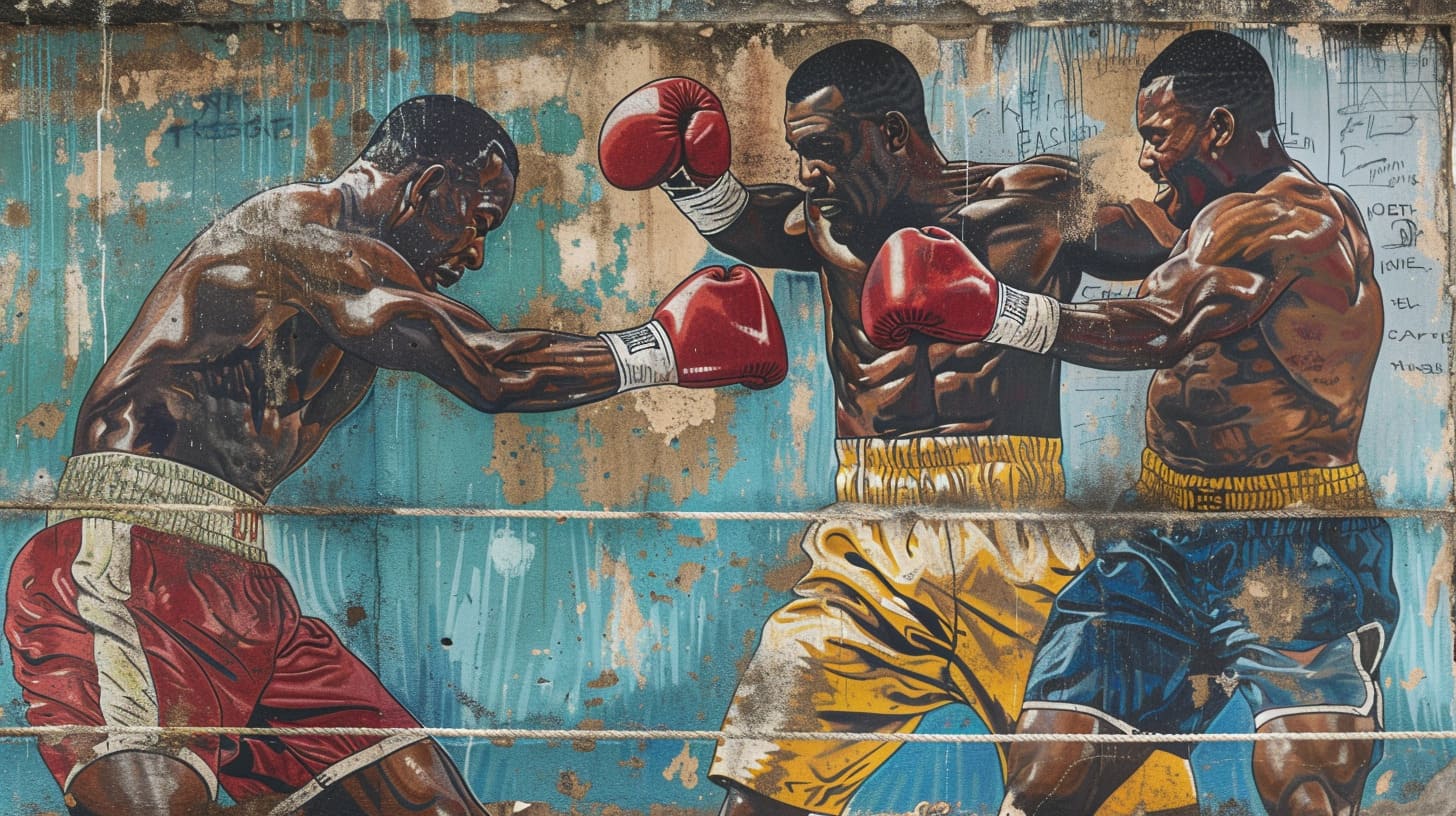The Cuban Boxing Style is synonymous with grace, technical finesse, and strategic brilliance, making it a revered method in the pugilistic world. It’s a distinct approach to boxing that emphasizes skillful footwork, deft defensive maneuvers, and a calculated offense designed to outwit opponents rather than relying purely on knockout power. This style, rooted in a rich boxing history, has produced numerous Olympic champions and has influenced fighters across the globe with its efficient and elegant technique. Let’s lace up our gloves and delve into the intricacies of this fascinating boxing tradition.
What Is Cuban Boxing Style?
Stepping into the ring with a touch of Cuban flair isn’t just about the fancy footwork; it’s an art steeped in strategy and finesse. So, what exactly sets the Cuban boxing style apart from the rest? Let’s unravel the tape around the gloves and dig into the heart of this enthralling technique.
The Cuban boxing style is an embodiment of precision, patient strategy, and a keen defensive posture that can be as mesmerizing as it is effective. It’s like a game of high-speed chess with gloves on. Here are the core principles that define this distinctive style:
- Defensive Mastery: Cuban boxers are often hailed for their exceptional defensive skills. They use their agility to evade punches with ease, mastering the art of ‘hit and not get hit’.
- Stellar Footwork: It’s all about the dance in the ring. Cuban boxers glide across the canvas, making it tough for opponents to land a clean shot.
- Measured Pace and Patience: These fighters don’t rush to knock out their opponents. Instead, they take their time, methodically breaking down the opposition with precision.
- Counter-punching: This style emphasizes the sweet science of counter-punching, turning an opponent’s attack into an opportunity for a sharp, calculated response.
Stance, Footwork, and Guard
Stance:
- Cuban boxers typically maintain a longer stance. This isn’t just for the show; it provides stability and the perfect launchpad for those quick, darting movements they’re known for.
Footwork:
- Think of their feet as brushes painting a masterpiece on the canvas of the ring. This makes them not only hard to hit but also positions them to strike effectively on the counter.
Guard:
- The high, tight guard is a fortress, keeping their chin tucked and hands up around the brow line. This minimizes the risk of taking a direct hit to a vulnerable spot.
Distinctive Elements of Cuban Boxing
Here’s a quick snapshot of what makes Cuban boxing stand out from other styles:
- Strategy Over Sheer Aggression: While many fighters rely on raw power, Cuban boxers lean towards a strategic approach, picking their shots with intent and intelligence.
- Adaptability: Whether it’s switching stances or changing tactics mid-fight, these boxers are chameleons in the ring, able to adapt on the fly.
- Schooling and Pedigree: Cuban boxers often come from rigorous training programs that emphasize technique and form from a very young age, ensuring they step into the ring as seasoned tacticians.
In conclusion, the Cuban boxing style is a craft honed through centuries of tradition. It’s a chess match dressed up as a fight, where movement, defense, and intellectual savvy reign supreme. It’s no wonder that this style continues to produce world champions who are revered for their skills and strategic brilliance.
Signature Moves & Strategies
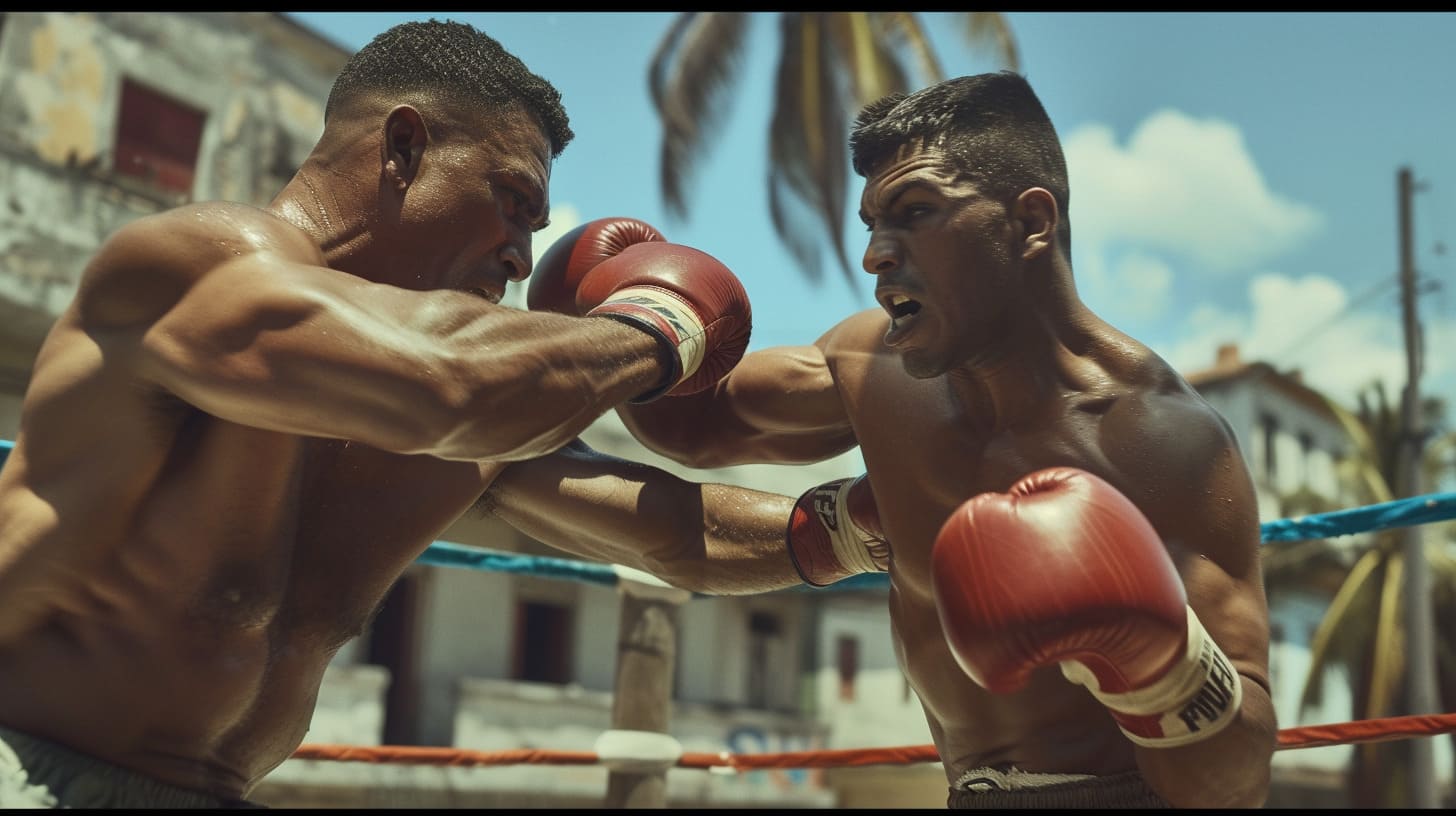
When you watch a Cuban boxer in the ring, there are a few trademark moves and strategies that you might notice. These aren’t just flashy tricks; they’re refined techniques that have been honed over decades to create a boxing style that’s as effective as it is distinctive.
The Out-Fighter Approach
The first thing to note about Cuban boxers is their love of the out-fighter technique. This style emphasizes staying outside an opponent’s reach and using a longer range to land punches. Cuban boxers are often seen dancing around the edges of the ring, conserving energy and looking for openings.
- Signature Move: The Jab. It sounds simple, but the jab is the bread and butter of the out-fighter. It’s used to maintain distance and control the pace of the fight.
- In Practice: Think about the legendary Teófilo Stevenson. The guy had a jab that could feel like a wrecking ball, snapping back heads and setting up his devastating right hand.
Counterpunching Mastery
Next up, Cuban boxers have turned counterpunching into an art form. They have a knack for baiting their opponents into making a move and then striking with precision when they’re most vulnerable.
- Signature Move: The Check Hook. It’s a fast, swooping punch that catches opponents off-guard when they come in too aggressively.
- In Practice: Felix Savon was a maestro of the counterpunch. He’d lure fighters in, make them miss, then make them pay.
Superior Footwork
Lastly, let’s talk footwork. Cuban boxing isn’t just about what you do with your hands; your feet have to tell the same story. Quick, light, and always balanced, Cuban boxers’ footwork allows them to flow around their opponents, making them hard to hit and even harder to predict.
- Signature Move: The Pivot. This move lets a boxer spin out of a tight spot and often leaves the opponent punching at air.
- In Practice: Guillermo Rigondeaux, whose ballet-like footwork has him in and out of range before opponents can even set their feet.
These moves aren’t just for show. They exemplify a boxing style that is about reading the opponent, controlling the distance, and striking with intention. It’s a chess game, and the Cuban boxing style brings a grandmaster’s foresight to every round.
Challenges and Limitations of the Cuban Boxing Style
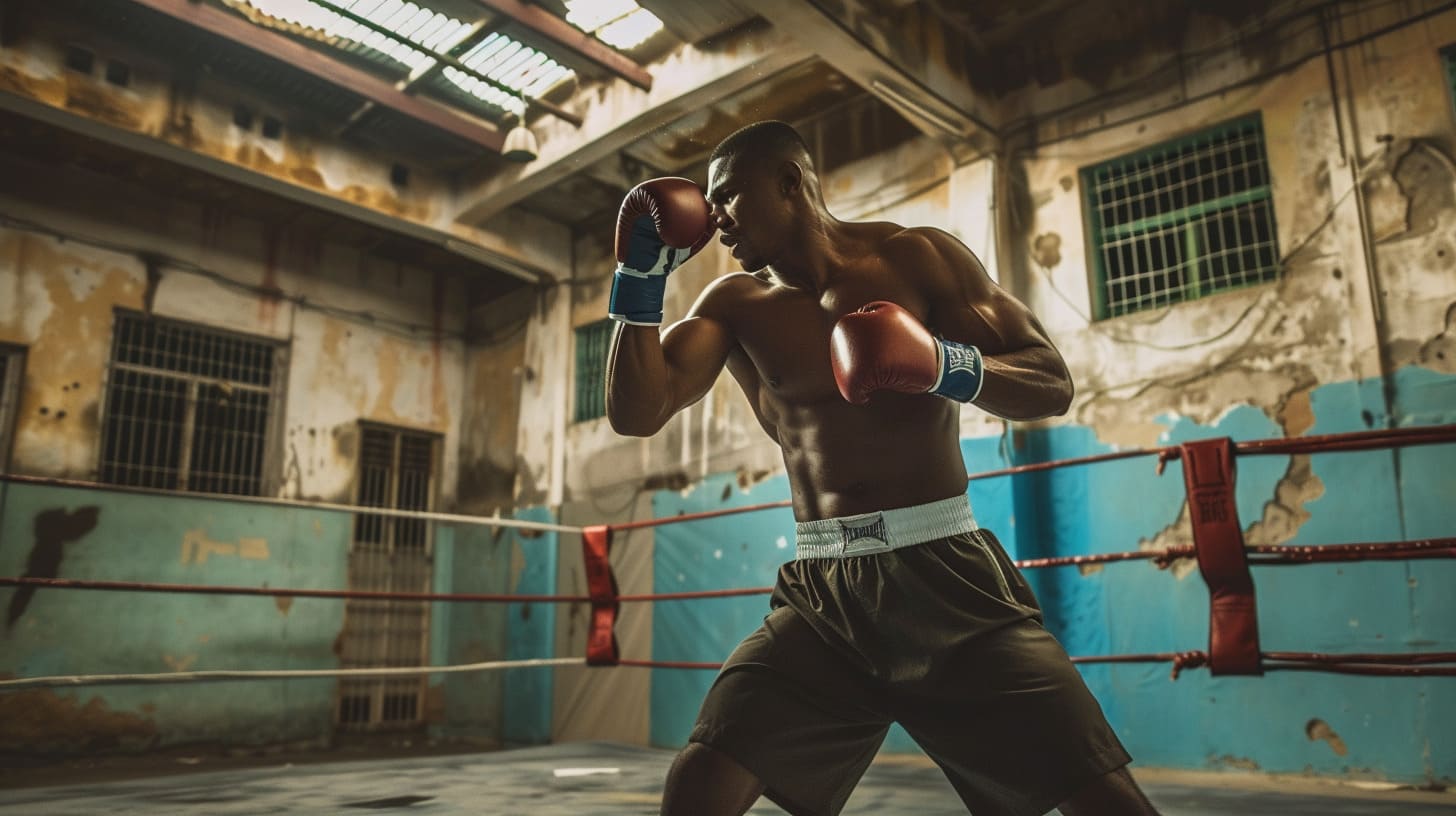
Let’s face it, no boxing style is perfect, and the revered Cuban boxing style is no exception. Known for its precision and flair, it’s worth diving into the limitations that even the most skilled Cuban boxers have to navigate.
Potential Weaknesses of the Cuban Boxing Style
At times, what makes the Cuban boxing style so fascinating can also be its Achilles’ heel. Let’s uncover the challenges boxers might face when adopting this style:
- Predictability: Once the rhythm and pattern of the defensive maneuvers are deciphered, opponents might anticipate and counter the moves.
- Aggressive Opponents: Fighters who maintain constant pressure and can close the distance quickly may overwhelm the Cuban style’s preferential mid-range combat.
- Adaptability: Being a style rooted in tradition, some argue that it may be less adaptable to the evolving, unconventional techniques seen in modern boxing.
The Benefits of the Cuban Boxing Style
When it comes to the Cuban boxing style, it’s all about outsmarting and outmaneuvering your opponent with finesse. Here’s a rundown of situations where this style shines brightest:
- Counter-Punching Opportunities: Thrives against aggressive opponents who leave openings as they come forward.
- Controlling Distance: Ideal in maintaining the perfect fighting distance, allowing for effective jabs and straight punches.
- Defensive Durability: Best employed in matches where avoiding hits is just as vital as landing them, showcasing excellent defensive skills.
- Strategic Fighting: Perfect for boxers who excel in reading their opponents and adjusting their tactics round by round.
When to Best Utilize the Cuban Boxing Style:
- During Championship Rounds: Endurance and strategic planning often come into play later in fights, where this style’s sustainability can outpace an aggressive opponent.
- Against Power Punchers: When going toe-to-toe with heavy hitters, the defensive acumen of the Cuban style can mitigate the damage and exploit counter opportunities.
The Drawbacks of Cuban Boxing Style
Even the slickest of styles can meet its match. Here’s where the Cuban boxing style might face hurdles:
- High-Volume Strikers: Boxers who throw a flurry of punches may disrupt the rhythm that Cuban boxers rely on.
- Inside Fighters: Opponents who excel in close-quarters combat can negate the preferred range and pace of the Cuban style.
- Unorthodox Styles: Fighters with unpredictable movements and angles can throw off the typically well-calculated Cuban defenses.
Strategies Opponents Might Employ:
- Constant Pressure: Keeping a Cuban boxer on the back foot limits their ability to set up and execute their game plan.
- Body Work: Targeting the body can wear down a fighter who relies on movement and stamina.
- Psychological Warfare: Getting inside the head of a traditionally disciplined Cuban boxer can lead to mistakes and open opportunities.
While this celebrated boxing style is undeniably effective, understanding both sides of the coin — its strengths and its potential drawbacks — is essential for any boxer looking to step into the ring with a Cuban strategy or against it.
Defending Against Cuban Boxing Style
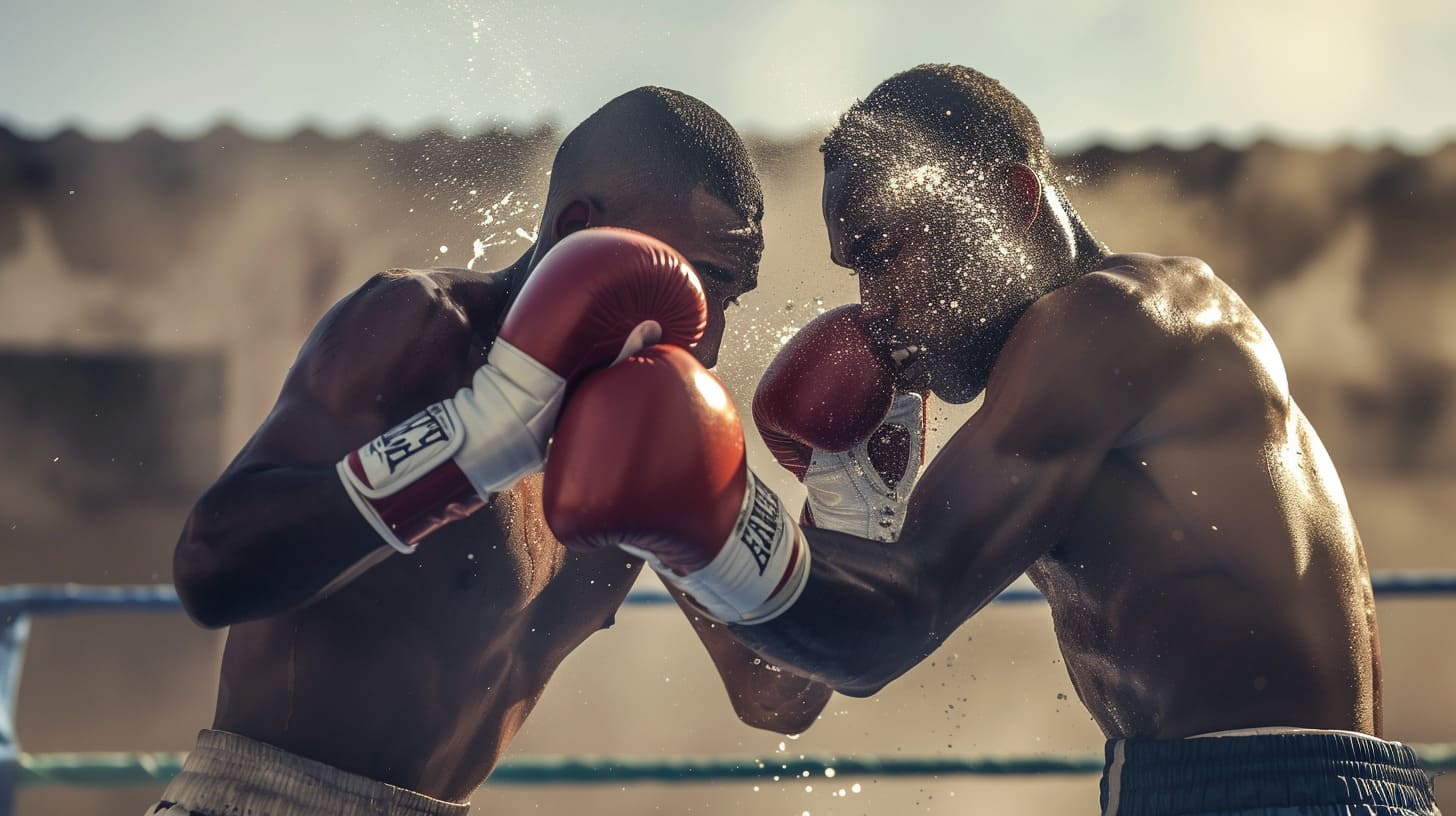
Jumping into the ring with a practitioner of the Cuban boxing style can sometimes feel like you’re trying to solve a particularly challenging riddle. Their mix of precise footwork, slick defense, and strategic savvy makes them formidable opponents. Let’s unpack the unique challenges this style presents on the defensive end, and gear you up with some tricks of the trade to hold your own.
The Cuban Conundrum: Style Challenges
Cuban boxers are known for their technical mastery, so when you’re up against them, expect a chess match rather than a brawl. Here’s what you’re up against:
- Masterful Movement: They’re always on their toes, making them hard to pin down.
- Defensive Dominance: These boxers often use a high guard and are experts at parrying punches.
- Counter-Striking Craft: They don’t just defend—they’re looking for openings to launch their own attacks.
To weather the storm, you’ll need to be as savvy as they are. Keep reading for some key defense tactics that could save your bacon in the ring.
Roll With the Punches: Tips for Defense
When you’re facing off with a boxer who has the magic of the Cuban style, you’ll need to stay one step ahead. Here are some practical tips to keep you standing when the gloves come at you with that Cuban rhythm.
Tip #1: Polish Your Footwork
Just like dancing, boxing is all about those feet.
- Work on lateral movement to help with ring positioning.
- Stay light and be ready to change direction quickly.
Tip #2: Precision Over Power
Rushing in with all guns blazing won’t cut it.
- Focus on accurate jabs to disrupt their rhythm.
- Aim to throw off their timing with feints and level changes.
Tip #3: Outwit with Intelligence
Think like a chess player; every move should be strategic.
- Anticipate their counter-strikes to avoid walking into traps.
- Be patient—wait for genuine openings rather than forcing the action.
Adding these defensive maneuvers to your repertoire can make a big difference. Now, for some extra nuggets of wisdom to weave into your game plan:
Additional Practical Tips:
Keep Your Guard High and Active:
- An energetic guard can thwart their precision strikes.
- Mixing guard patterns can confuse and deter their offense.
Stay Mentally Nimble:
- Cuban boxers love to play mind games; don’t get frustrated.
- Integrate psychological warfare by exhibiting confidence and control.
Work the Angles:
- Avoid being a stationary target by continuously moving at angles.
- This can create openings in their defense and give you an edge.
These tips aim to give you a foundational strategy to counter the Cuban boxing style’s unique challenges. Remember, adaptability is critical—you’ve got to be as fluid as the style you’re trying to outmaneuver. So lace up, stay sharp, and let’s show that Cuban style that it’s not the only trickster in the ring.
Notable Practitioners of the Cuban Boxing Style
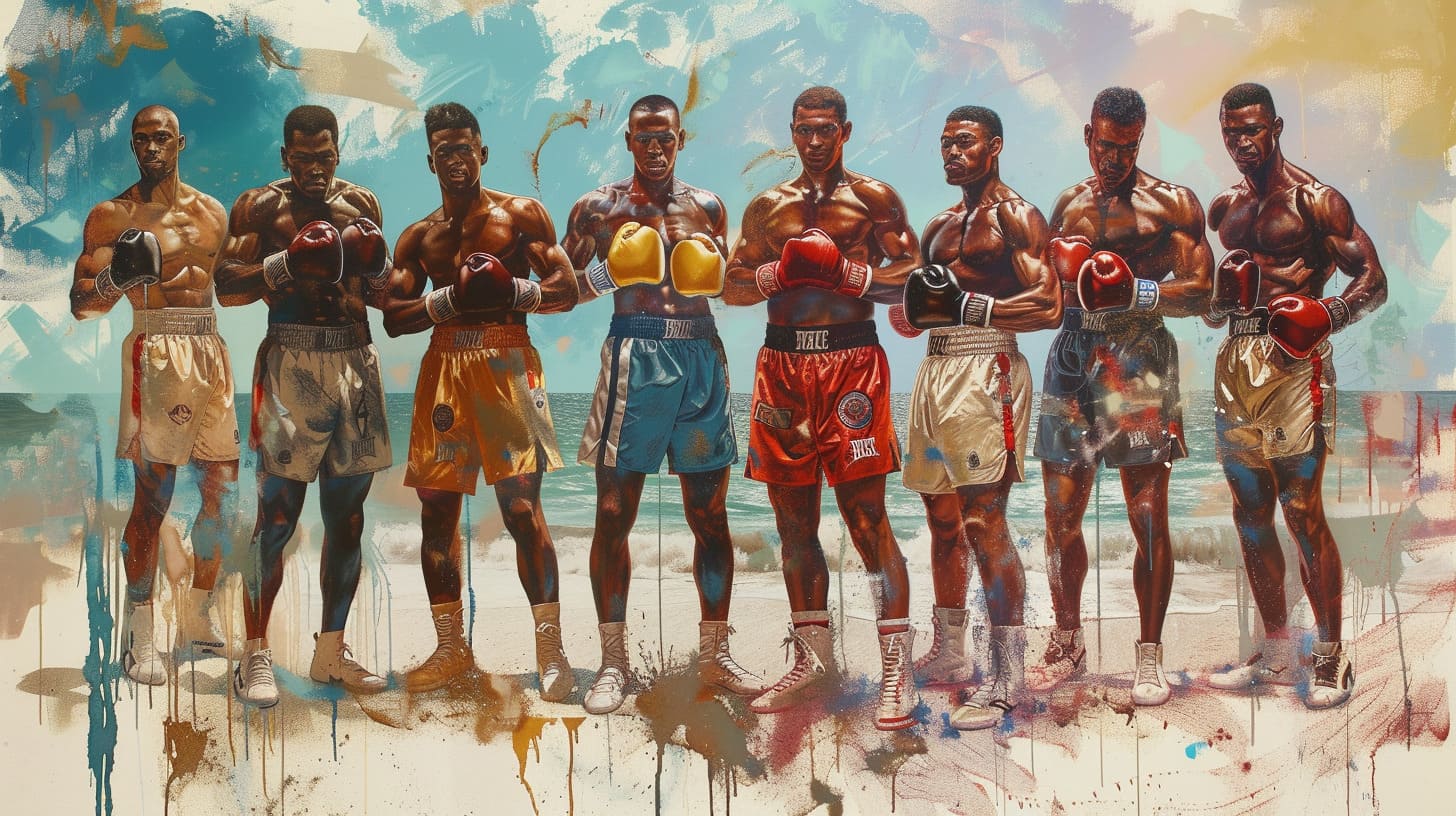
When you think of the Cuban boxing style, it’s like a smooth Salsa rhythm — there’s a dance-like quality to it that mesmerizes the audience. Let’s meet a trio of boxers renowned for moving to this beat so brilliantly in the ring.
Teófilo Stevenson
The name Teófilo Stevenson is often synonymous with Cuban boxing excellence. With a towering presence, and a lethal right hand, Stevenson ruled the heavyweight division in amateur boxing like it was his personal kingdom.
- Olympic Golds: Stevenson claimed Olympic gold three times (1972, 1976, 1980), solidifying his place in the pantheon of Olympic greats.
- World Championships: He conquered the World Championships as well, securing gold in 1974, 1978, and 1986.
- Signature Fight: His matchup against Tyrell Biggs in the 1984 World Championships showcased the Cuban boxing style’s dominance, even though Tyrell was a star in his own right.
Felix Savon
If Stevenson was the king, Felix Savon was the emperor of Cuban boxing. He followed in Stevenson’s footsteps but added his own flavor to the Cuban style. His reign extended into a new era, with a compelling mix of power and skill.
- Olympic Golds: Savon stepped onto the highest podium three times as well, clinching gold in 1992, 1996, and 2000.
- World Championships: With six gold medals between 1986 and 1997, he was unstoppable on the global stage.
- Memorable Moment: Savon’s powerful punches in the 1992 Olympics final were like thunderclaps, announcing the arrival of a boxing titan.
Guillermo Rigondeaux
The modern torchbearer of the Cuban boxing style is none other than Guillermo Rigondeaux. His boxing is a poetic display of technical mastery, underpinned by a solid amateur foundation.
- Olympic Golds: Not to be outdone, Rigondeaux claimed his own set of Olympic gold medals in 2000 and 2004.
- Professional World Titles: Stepping into the pro ranks, he dazzled with two world titles at super bantamweight, among other accolades.
- Iconic Bout: His sublime defensive performance against Nonito Donaire in 2013 was a masterclass in the Cuban boxing repertoire — precise, fluid, and always one step ahead.
These Cuban boxing maestros have etched their names in history, not just through their triumphs but the grace with which they’ve danced around their opponents, making the sweet science look like the smoothest dance you’ve ever laid eyes on.
Training and Conditioning for Cuban Boxing Style
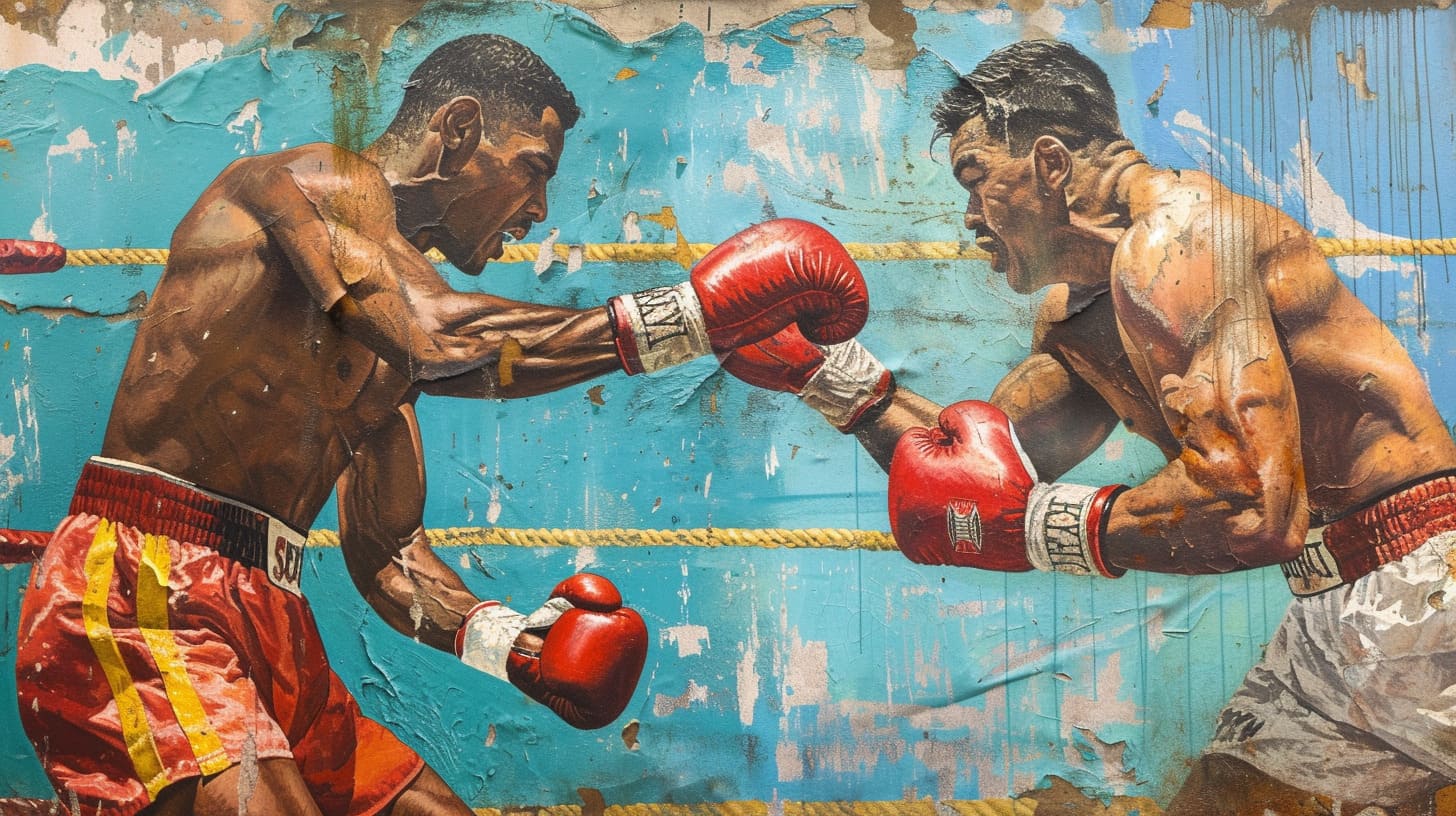
If you’ve been drawn to the sleek, strategic nature of the Cuban boxing style, you’re likely itching to know how to train like the champions hailing from this boxing-rich island. The good news is, with dedication and the right kind of training, you can start to incorporate key elements of their methods into your own routine.
Drills to Develop Cuban Boxing Techniques
Let’s start with drills because they’re the bread and butter of any serious training regimen. Cuban boxers are known for their impeccable technique, so drills that sharpen your skills are essential.
- Shadow Boxing: Emphasize movement and footwork. Imagine your opponent and work on your defensive maneuvers just as much as your offensive ones. This is where you can start to mimic the fluidity and rhythm that Cuban boxers are famous for.
- Speed Bag Work: This isn’t just about developing quick hands; it’s also about rhythm and timing. Try to maintain a steady tempo and use this drill to improve your hand-eye coordination.
- Defense Drills: Partner up and work on parries, blocks, and slips. The Cuban style places a lot of emphasis on not getting hit, so these drills will help you to become elusive in the ring.
- Sparring: Yes, it’s an obvious one, but the right kind of sparring is crucial. Keep it technical and focus on your defense as much as your offense. Sparring with a more experienced boxer who can mentor you in the style can be incredibly beneficial.
Strength and Conditioning Specifics
In addition to technical drills, a robust conditioning routine will round out your training to truly encapsulate the Cuban style. Start with these exercises:
- Roadwork: Classic long-distance running will build up the endurance you need to maintain the Cuban style’s high-paced movement throughout every round.
- Plyometrics: Incorporate explosive movements like jump squats and box jumps to develop the power behind your punches and the springiness in your steps.
- Core Workouts: A strong core is vital for quick twisting motions and delivering power. Don’t skimp on planks, Russian twists, and medicine ball exercises.
Fine-Tuning Your Cuban Boxing Toolkit: Additional Tips
When embracing the Cuban boxing style, there are nuances you should keep in mind that can really elevate your technique:
- Patience and Strategy: The Cuban method isn’t about brawling; it’s about outsmarting your opponent. You need to cultivate patience and always have a game plan.
- Watch and Learn: Study footage of Cuban boxers. Look at their movement, their defensive strategies, and how they set up their attacks. There’s a wealth of knowledge in those videos.
- Regular Feedback: Have a coach or knowledgeable training partner observe you and provide feedback. Small adjustments can lead to significant improvements.
- Condition Your Mind: Mental toughness and the ability to adapt mid-fight are hallmarks of Cuban boxers. Incorporate visualization and other mental training strategies to sharpen your in-ring IQ.
- Rest and Recovery: This is when your body repairs itself and gets stronger. Make sure to balance intense training with proper rest to avoid burnout and injuries.
By focusing on these elements, you’ll start honing the skills and physical attributes that make the Cuban boxing style so effective and admired in the boxing world. Remember, it’s not just about how hard you train, but how smart you train. Keep at it, and poco a poco (little by little), the art of Cuban boxing will become a part of your own fighting repertoire.
Final Thoughts
So, there you have it, a whirlwind tour through the world of Cuban boxing style — an elegant, strategic approach that continues to dazzle fans and frustrate opponents. It’s a style that relies on rhythm, precision, and patience, melded together by a storied history of boxing excellence. Whether you’re considering adopting this style or you’re simply a fan of boxing’s rich tapestry, the Cuban approach is a shining example of boxing at its cerebral, graceful best. And if this has inspired you to lace up a pair of gloves and float like a butterfly around the ring, remember, every champion starts with a dream, a pair of gloves, and the will to step into the ring. Share your thoughts below, and let us know how the Cuban boxing style has influenced your love for the sweet science!
Additional Resources
Diving into the unique rhythm of the Cuban boxing style can be a thrilling journey. To feed your curiosity and to get you even more hooked on this mesmerizing boxing style, I’ve rounded up some resources that’ll turn you from a spectator into an aficionado. Whether you’re aiming to fine-tune your own practice or just want to appreciate the finesse of Cuban boxing, these resources are your cornermen, ready to coach you through.
Books Worth Reading
- The Sweet Science by A.J. Liebling
- While not exclusively about Cuban boxing, its insightful look at the sweet science of boxing provides the perfect backdrop for understanding the meticulous craft of styles like the Cuban.
- Find it on Amazon
- Boxing: A Cultural History by Kasia Boddy
- This book offers a panoramic view of boxing’s history and its various styles, touching upon Cuban boxing’s influence within the global boxing scene.
- Available here
Articles to Learn From
- “The Cuban Boxing School: The Key to Success”
- An article diving into the methods and philosophy behind the Cuban success in the ring, a great read for understanding the tradition and the technical nuances.
- Read the article
Videos to Watch
- Cuban Boxing Footwork & Drills on YouTube
- A crisp, clear tutorial that breaks down the classic footwork and drills that make the Cuban style so elusive and effective.
- Watch it here
- Cuba’s Boxing Revolution (Documentary)
- This documentary provides an intimate look at the Cuban boxing phenom, covering the journey of young boxers aiming for Olympic glory.
- Discover the story
Websites to Browse
- World Boxing Association
- The WBA’s website often features articles on various boxing styles, including analysis of the Cuban technique.
- Check it out at www.wbanews.com
- International Boxing Association (AIBA)
- Here you’ll find regulations and insights that can help you understand the formal aspects that Cuban boxers so brilliantly navigate.
- Visit their site at www.aiba.org
Immerse yourself into these resources and let the rhythm of the Cuban boxing style resonate with your spirit. Each page you turn, video you watch, and article you skim will bring you closer to the beating heart of this pugilistic art form.
